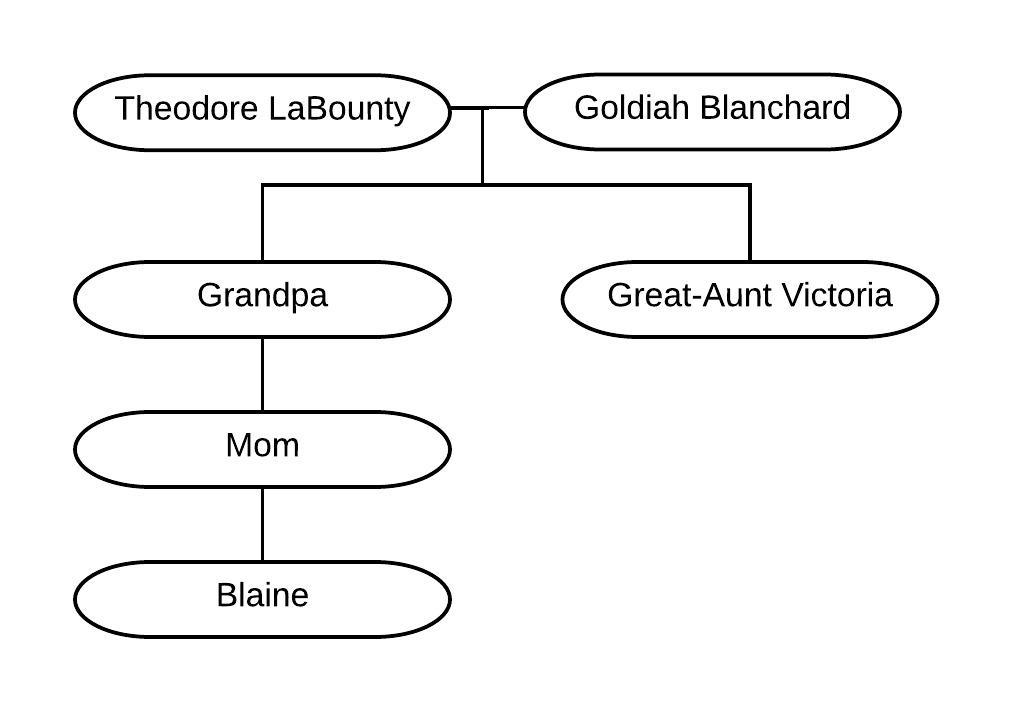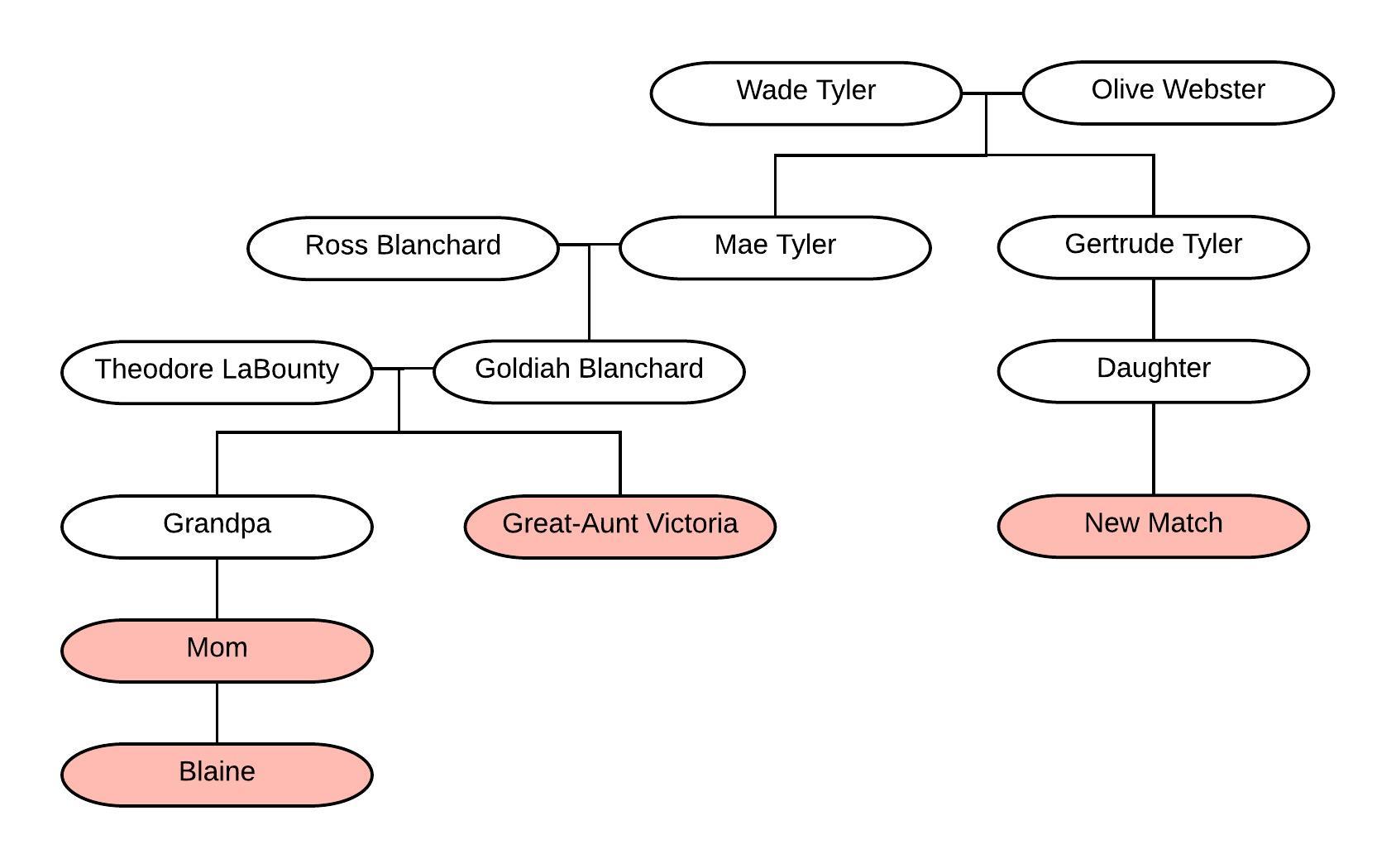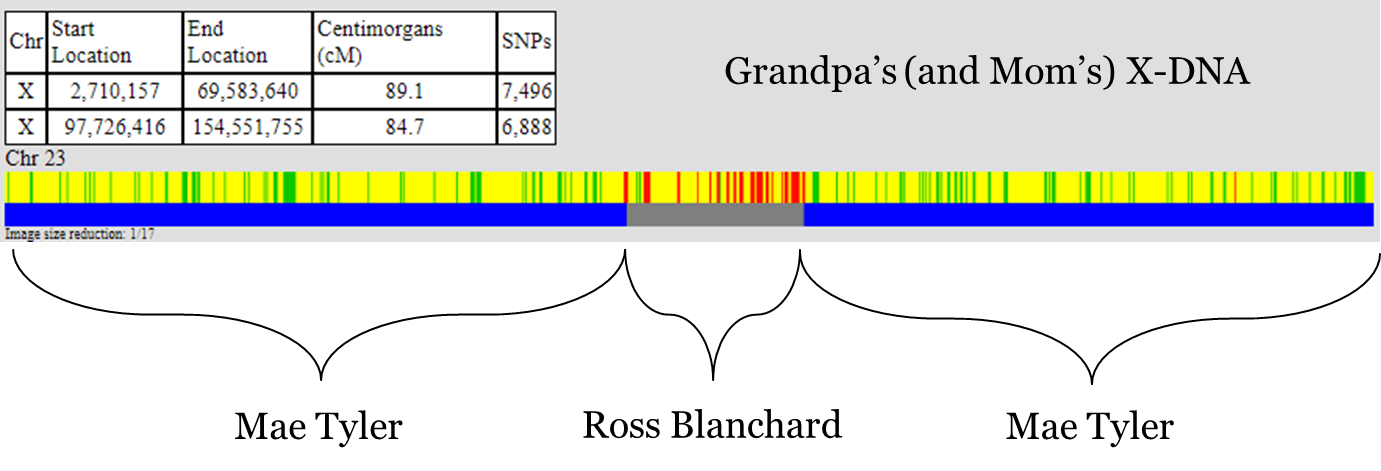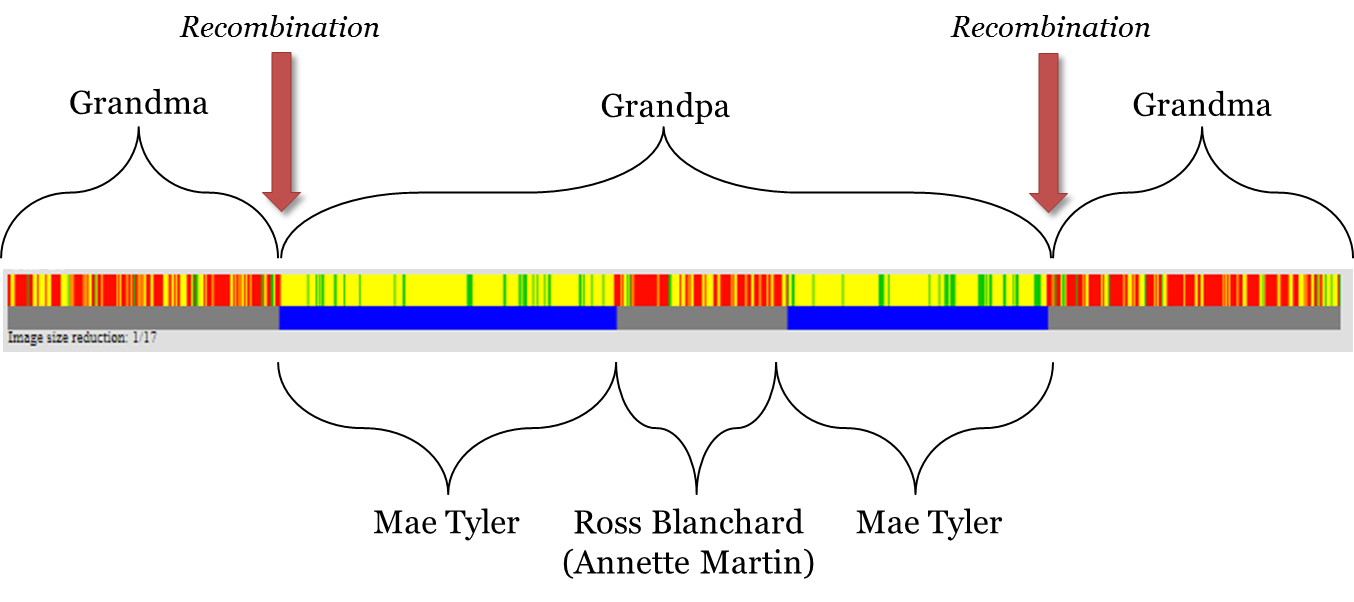This summer, I finally asked my maternal great-aunt (we’ll call her “Victoria”) if she was interested in testing her DNA for me. She agreed, and we sent off a sample of her DNA to Family Tree DNA for mtDNA and atDNA analysis. A few weeks later, the results were back and ready for digging in!
I found a close match that shared 201 cM (including 47 cM on the X chromosome). This close match had a tree, and I immediately found the most likely common ancestor. The shared X-DNA interested me the most, and I decided to review that a little closer.
Mom and My Great-Aunt Victoria
My mother is the daughter of Victoria’s brother. Now, that means that my mother has an exact copy of her father’s X chromosome (daughters receive a copy of their father’s single X chromosome). Any X-DNA that my mother and her aunt Victoria share, is the same X-DNA that her father and Victoria shared.
Here’s the tree:

And here’s the DNA that my mother and Victoria share in common (and thus the DNA that siblings Grandpa and Victoria shared in common):

Now, I also know that since Grandpa inherited only X-DNA from his mother Goldiah Blanchard (males only receive X-DNA from their mother), I know that the X-DNA that Grandpa and Victoria share came from Goldiah Blanchard.
Grandpa and Victoria share almost a full chromosome. It appears that, at a minimum, there were two recombination events that occurred when Goldiah gave an X chromosome to either Grandpa or Goldiah.
Great-Aunt Victoria and her Second Cousin
As I stated, there was a new match that shared 201 cM (including 47 cM on the X chromosome), which appeared to be a second cousin:

Victoria and New Match share this X-DNA:

This X-DNA, therefore, came to them from their shared X-DNA ancestors Wade Tyler (b. 1856) and/or Olive Webster (b. 1862) who lived in Upstate New York.
Mind the Gap (97,000,000 to 155,000,000)
My mother and New Match share this X-DNA (which again, came from Wade and/or Olive):

As you can see above, Victoria shares 48,806,648 – 120,403,501 with New Match, while my mother is missing a gap in there. Remember the gap in sharing between my mother and Victoria? Here it is:

Remember, this is the same X-DNA that my mother’s father (“Grandpa” in the charts) shared with Victoria. So Grandpa and Victoria shared a lot of X-DNA, but didn’t share that gap. What can I learn about the source of their X-DNA, and this gap, from the X-DNA shared with the New Match?
My grandfather received a single X chromosome from his mother Goldiah, and that X chromosome could have ONLY come from Ross Blanchard and/or Mae Tyler. It may be a mix of both, or it may be an entire copy of the X chromosome that Goldiah received from Ross Blanchard, or it may be an entire copy of the X chromosome that Goldiah received from Mae Tyler. About 86% of the time it will be a mixture, and about 14% of the time it will be one or the other full X chromosome without change.
As you can see above, Victoria shares the gap region with New Match, meaning that her gap region came from Mae Tyler. If grandpa didn’t inherit the gap region from Mae Tyler (which he didn’t because my mom doesn’t match either Nancy or New Match in the gap region), he must have inherited it from Ross Blanchard. Thus, grandpa’s gap came from Ross Blanchard!
So, absent any recombination events that occurred at EXACTLY the SAME spot in BOTH transmissions to grandpa and to great-aunt Victoria, it appears that my great-aunt Victoria inherited a full, unchanged copy of the X chromosome that Goldiah received from Mae Tyler, and my grandfather inherited a mixture of Mae Tyler and Ross Blanchard’s X chromosome as follows:

Blaine’s X-DNA
I received a copy of the X chromosome from my mother. My mother has two X chromosomes (the copy of grandpa’s X chromosome, above, and a copy from my maternal grandmother), and I could have inherited one of the following:
- A full copy of grandpa’s X chromosome, unchanged (in which case I would match great-aunt Victoria and New Match exactly the same as my mother does);
- A full copy of of my maternal grandmother’s X chromosome, unchanged (in which case I would share NO DNA with either great-aunt Victoria or New Match); or
- A mixture of grandma and grandpa’s X chromosomes.
Numbers 1 and 2 happen about 14% of the time, while #3 happens about 86% of the time. And sure enough, I fall into category #3.
I share the following X-DNA with my great-aunt Victoria:

And I share the following X-DNA with New Match:

This suggests that my mother recombined her X chromosomes thusly when creating the egg that led to me:

Mae and Ross were both born about 1820, so I’ve tracked these portions of my X-chromosome back in time approximately 137 years. And, really, since the X chromosome that Ross Blanchard passed down came from his mother, I’ve tracked that segment back to his mother Annette Martin (my 3rd great-grandmother), born about 1856 in Essex County, New York.
My Siblings’ X-DNA
Interestingly, this also tells me quite a bit about my siblings’ X chromosomes (my brother and my sister). They share a full X chromosome in common:

And they share no DNA with their great-aunt Victoria:

They share the ends of the chromosome with me:

So, based on this, I can reasonably conclude that they BOTH received the same full copy of the X chromosome that our mother received from her mother, my grandmother. This will be somewhat rare since there is only a 14% chance that one person will receive an unrecombined X chromosome, but it isn’t exceptionally rare.
All this from a single New Match, prompted by testing my great-aunt Victoria. Test the older generations today!
Great case example on the X, especially any gap. With gratitude to you, Blaine, for all you do to educate us on genetic genealogy.
Thank you, so nice of you to say, and I’m so glad you enjoyed it!
This is fascinating! Thank you for sharing. Most intriguing to me is the 14% chance of getting the whole X from one of the mother’s parents. Is there further documentation on those chances somewhere? Is this something new science has learned since more and more data started coming in?
Thank you! There’s a lot more information in the recombination study I pre-published earlier this year: https://thegeneticgenealogist.com/wp-content/uploads/2017/02/Recombination_Preprint.pdf
“The Recombination Project: Analyzing Recombination Frequencies
Using Crowdsourced Data”
This is so very well written & fascinating. I’m a beginner in analyzing chromosome segments, so this article had helped me out tremendously. I’m still figuring out how you identify recombination & what it means for the relationship, so I’ll read this a few more times & will order your book for my Black Friday present 🙂
So glad you enjoyed it! Best of luck analyzing your DNA!
Outstanding case study. Thanks, as always for sharing your experiences. I’m glad I haven’t begun working on my X mapping….yet. No more excuses. 🙂
Blaine, see statement ” Grandpa and Victoria share almost a full chromosome. It appears that, at a minimum, there were two recombination events that occurred when Goldiah gave an X chromosome to either Grandpa or Goldiah”. Isn’t that supposed to read grandpa or Victoria?
Blaine. Thank you for this detailed example. My mom was tested this week and my brother has already tested. Now you have given me inspiration And information as to what i can learn from the results. Also now i can explain to my aunt, who tested on Ancestry, why i need her to transfer her results to gedmatch.
I am very new and haven’t studied genetic inheritance at all. What do you suggest I read first? My one question right now is:
Do my Children inherit a percentage of every region that I show an inheritance from?
Some regions they show no percentage at all, but not too many, and not major percentages..only the smaller percentages.
I was surprised to find a large percentage of Ireland, Scotland and Wales 24%. My husband’s Father was Irish, although he hasn’t done his DNA yet. My Daughter shows
6%…shouldn’t she show more?
I just read this Aunt Victoria X-DNA article. I compared mine to my dad’s, then mine to my mom’s. They were both the same, with the same solid blue line like your siblings.
Pam/Dad
Chr Start Location End Location Centimorgans (cM) SNPs
X 2,321 154,886,292 194.8 17,624
Pam/Mom
Chr Start Location End Location Centimorgans (cM) SNPs
X 2,321 154,886,292 194.8 17,605
Is this normal for parent/child…for them to both be the same for X-DNA?
Thanks,
Pam
Hi
I have an X question. I am female.
My father is Native American and my mother is not (from what she knows). I was confused by my 23andme results that showed 1 chromosome (from my father) to be mostly Native American (which was expected) but the one from my mother also had a small amount of NA DNA.
I decided to have her take the 23andme test just to see what would show up. Her test showed 100% European. I understand that my father’s X is passed to be un-recombined. I also understand that my mother’s 2 Xs recombine and then I receive 1. What I don’t understand is how both of my Xs have NA DNA on them if only 1 parent is Native American. Is there something I am missing??
Blaine,
I have a new match on FTDNA. The match is a female. Greater than 5 cM, we share DNA on 2 CHR. We share 8.94 cM on CHR 13 and 6.16 on CHR 16. The interesting match is on “X”. We share 195.93 cM on the X CHR. My understanding of X DNA is 195 cM is the whole CHR. Can you interpret this for me?
Thank you,
Jim
It is always interesting to read any information about DNA. This theme is so difficult and deep that sometimes I’ve got lost. Maybe the best thesis writing service at Essay Review Expert could help me to choose the right service for study. I want to learn more to be honest. But sadly there no much time for this.
Here https://beforeitsnews.com/education/ you find something interesting
I remember when we were forced to write an essay in college about the DNA structure. It was very difficult, but it was possible to implement it. There’s nothing super complicated about it. Fortunately, I was able to find people who were able to provide me with professional help on this issue. It was the only way to help me do this difficult work. They provided me with examples and so on. My supervisor was very surprised at this level of work. I recommend that you also think about looking at pickthewriter.com to see what companies provide such services. There are professionals here who know what they should do and how. So make sure you take a look and get acquainted with them. I think it will be useful for anyone who writes the same work now. It’s easy to make a mistake here, because a professional approach is just necessary. Besides, it will help you to enrich your knowledge with information from different sources.
I remember when we were forced to write an essay in college about the DNA structure. It was very difficult, but it was possible to implement it. There’s nothing super complicated about it. Fortunately, I was able to find people who were able to provide me with professional help on this issue. It was the only way to help me do this difficult work. They provided me with examples and so on. My supervisor was very surprised at this level of work. I recommend that you also think about looking at https://pickthewriter.com/ to see what companies provide such services. There are professionals here who know what they should do and how. So make sure you take a look and get acquainted with them. I think it will be useful for anyone who writes the same work now. It’s easy to make a mistake here, because a professional approach is just necessary. Besides, it will help you to enrich your knowledge with information from different sources.